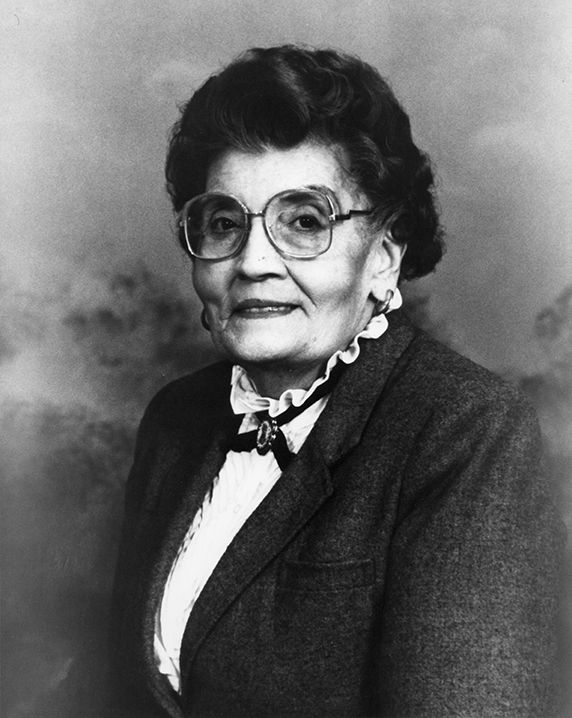The “Grand Lady of the Métis”

Anne Anderson was born Feb. 3, 1906 in St. Albert, Alta., the third of 10 children born to William Gairdner and Elizabeth Calliou. Her father was of French and Scottish decent; her mother was Cree. She was very tiny and frail at birth, so small that her cradle was a shoebox lined with rabbit fur. Her mother was worried that little Anne would not survive. She called in a medicine man and asked him to bless her and make her strong. He assured her mother that Anne would not only survive but grow to be a strong woman and live a rich and rewarding life, accomplishing much.
She attended Bellrose school and spent three years with the Grey Nuns at their convent where she was sent at the age of ten. She completed sophomore year there before she had to leave in order to help her parents on the farm. When she was sixteen her father died and she began to do housework for neighbors as well to help support her mother and siblings.
Anne learned the Cree language and Cree way of life from her mother who urged to to always speak the Cree language. She learned of the culture from the Elders who taught through stories. The Elders are “keepers of Knowledge” and they are central to preserving the culture. The Cree strive for balance in all relationships and seek the wisdom of the Elders to achieve this.
The Cree were primarily hunters who tracked caribou, elk and moose as well as smaller game such as beaver and rabbit. The Plains Cree followed the buffalo herds in a nomadic lifestyle. The Eastern Cree fished and hunted seals from canoes.
The Cree are one of the largest groups of First Nations in North America. In Canada, over 350,000 people are Cree or have Cree ancestry. The major proportion of Cree in Canada live north and west of Lake Superior, in Ontario, Manitoba, Saskatchewan, Alberta and the Northwest Territories. About 27,000 live in Quebec.
Anne’s mother believed that the language and culture of her tribe had to be preserved. Their language was spoken but not recorded. When she was on her deathbed she begged her daughter to record the language in written form so that it would be preserved. Anne promised that she would. Over the decades she did just that so it would not only be remembered but promoted.
That promise was well kept. Anne Anderson has more than ninety published works, including a Cree dictionary containing 38,000 words that she published in 1975. In 1985 she published The First Metis ... A New Nation, which documents several generations of Alberta Metis families and information about the history and way of life of the early Metis people.
Anne also recorded Cree language tapes to ensure the sound and pronunciation of the language would be preserved. She introduced Cree classes to the Edmonton schools and across the country, thus adding the road of teacher to her resume. Doctor Anne founded Cree Productions, a company dedicated to producing educational resources that could spread the Cree language beyond the reach of her own classes.
She was well loved, respected and in great demand. She taught at many of Alberta’s post secondary institutions, including the University of Alberta, Grand MacEwan College and Fairview College. She also taught in the jail at Fort Saskatchewan and at the Charles Camsell Indian Hospital in Edmonton.
She was also involved in a number of other organizations, including the Native Brotherhood Society, the Alberta Native Teachers' Society, the Voice of Alberta Native Women and the Edmonton YWCA. She had a hand in the creation of the Native People's Garden at the Devonian Botanic Garden west of Edmonton by providing advice and information on traditional Native uses of the plants found within the garden.
She received many honors during her career, an Alberta Achievement Award in 1975, in 1978 she received an honorary doctorate of laws from the University of Alberta in recognition of her work as a writer and teacher in 1978. In 1991 she received the Order of Canada for her work promoting Cree and Metis culture. She was also named a YWCA Edmonton Woman of Distinction in the Arts and Culture category and a received a Heritage Language Development Award from the Alberta Multicultural Commission that same year.
She was named to the City of Edmonton's Cultural Hall of Fame in 1992 in the builder category and in 2004, during Edmonton's centennial celebrations, was named as one of the city's 100 Edmontonians of the century, recognizing, among other things, her efforts to introduce Cree classes into city schools.
The City of Edmonton has also named a park in her honor.
During her lifetime, Anderson taught three generations about the Cree language, culture and knowledge. She passed away April 21, 1997 at the age of 91, but even now, others continue to build on the foundations she laid, working to ensure current and future generations of Cree and Metis people never lose touch with who they are.





Kommentare